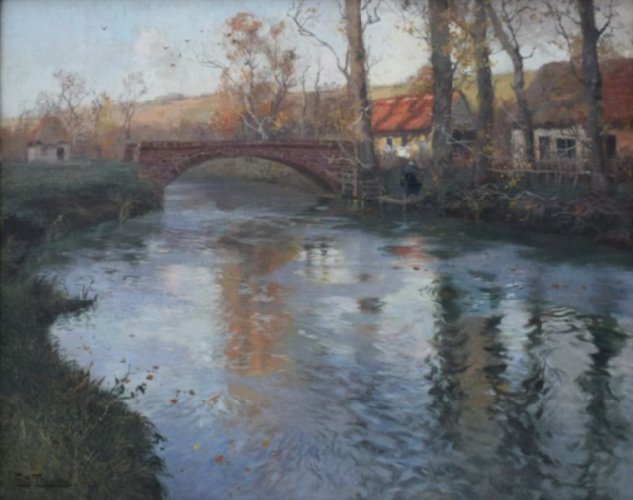Description:
Johan Frits Thaulow (1847-1906) studied at the Academy in Copenhagen and Karlsruhe. Visits to France had a great influence on his work and encouraged him to establish the “Freilu–ftakademie“ to fight against the traditions of academic painting in Norway. Eventually he moved to northern France and became a member of the Société Nationale des Beaux–Arts. The most repeated motif in his art was a river shown at different moments of the day. He was particularly interested in the so–called “blue hour“, a short moment of twilight when the world is colored blue. In the peaceful, blue, like a clear sky waters of the river, the trunks of the trees growing on the banks and the white walls of the village houses nestled behind them are reflected. A brick bridge stretched across the river connects two grassy banks. From behind it rises a tree covered with autumn leaves, whose reflection sparkles with oranges in the river current. Autumn leaves float picturesquely on the water. On the right, more densely populated bank, laundry is hung on a rope between the trees. From the water, a woman in dark clothes and a white bonnet returns. Her small figure, almost invisible, as if merging with the landscape, is part of it. In the background, bright fields stretch out, and on the blue sky a few birds fly.
The observation of the light relationships that occur in the landscape during late evening, night or morning was particularly attractive to the artist. Although these landscapes of the Norwegian artist have realistic features, the specific atmosphere in them creates an almost romantic mood. In Norway, Thaulow became famous as a painter who transferred the experiences of the Impressionists to the Scandinavian soil. The paintings often depict winter landscapes in which the painter tried to capture a very short, fleeting moment, the so–called “blue hour“, when after sunset, but before the complete darkness, the world is colored in various shades of blue. When he moved permanently to France, he also focused on painting the nature of small towns, villages, or uninhabited areas, as in the case of the presented landscape.


